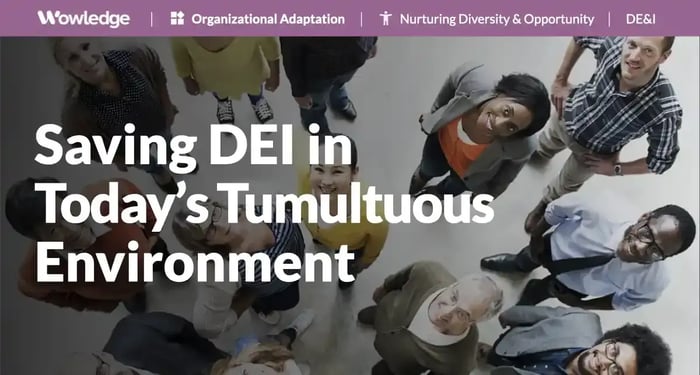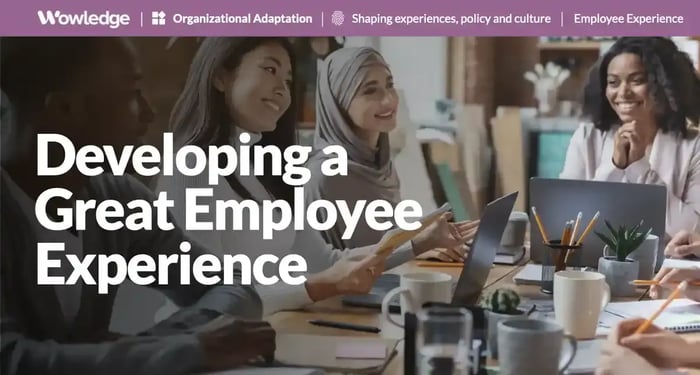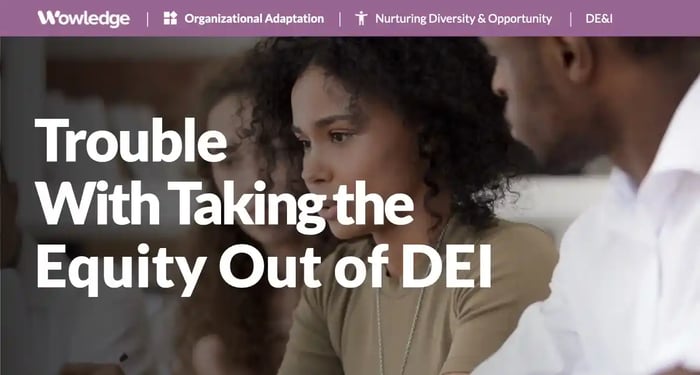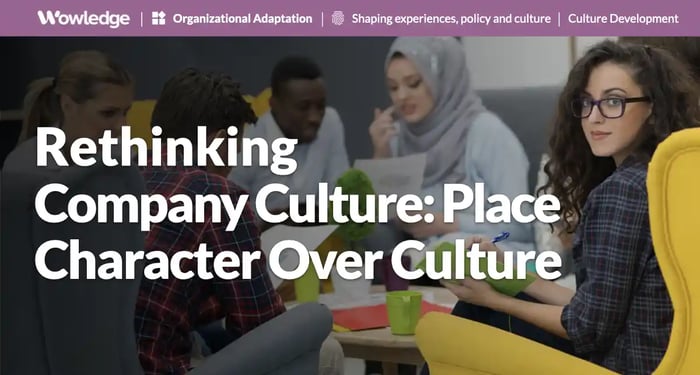Table of Contents
- Why is DEI controversial and why are swings in its acceptance occurring?
- The realities of today’s workforce
- The real problem for employers around DEI
- The impacts and resulting challenges companies face
- So, what can be done to overcome these challenges and negative effects?
- 1. Get real about the need for DEI-related capabilities
- 2. Set expectations that with or without a DEI function, fairness still must exist
- 3. Measure impact vs activity
- 4. Recognize that training only takes you so far
- 5. Update leadership and managerial incentives and rewards
- 6. Leverage ERG’s more heavily for staffing, inclusionary activities
- 7. Recruit HIPOs from HBCUs and HSIs
- 8. Hire women and people of color into DEI leadership roles
- 9. Avoid anti-DEI political opinions creeping into the company’s strategic direction
- Relevant Practices & Tools
- FAQs
We continue to be agitated by the spate of corporate layoffs, which have hit Diversity, Equity & Inclusion (DEI) functions particularly hard, resulting in disproportionate reductions in both top management and their teams. While this is certainly a corporate overhead function putting it at greater risk of staff cuts, it is nonetheless frustrating to watch a lot of name companies seemingly reduce their commitment to an increasingly diverse workforce. So, can we save DEI?
For example, over the last few years, Amazon, Twitter, Nike, Capital One, Applebee’s, Wells Fargo, Intel, Meta, and Wayfair have all reported cuts in senior DEI roles. Revelio Labs also reported that DEI positions were hit with a disproportionate 33% reduction, compared with a 21% cut for other roles. This bumps up hard against the sharp increases that SHRMs research showing that DEI roles increased by 55% starting in 2020 following demands for broader racial equity and justice after the protests related to George Floyd.
What happened and why the sudden corporate retreat from a focus on diversity in their ranks? How important is DEI in today's and tomorrow’s world, and what can be done to stem the sudden wave away from that commitment? Why, and how should we save DEI?
Why is DEI controversial and why are swings in its acceptance occurring?
DEI's rise started with the changes that we are experiencing globally, with swings in birth rates as well as increases in immigration and associated population shifts. Keeping this movement alive in organizations has been a continuing sensitivity to past employment trends that have handicapped women and people of color. More recently, severe labor shortages and changes in workforce preferences that came about from COVID-19, and an increased focus on all available workers, but especially those from diverse (i.e., non-white, female) backgrounds occurred. A concomitant need came about to appeal to a broader swath of the working population through employment policies, branding, and actions that make organizations more attractive and welcoming as a place of employment.
Another major swing came in the form of the Black Lives Matter protests in 2020, after which organizations of all stripes made promises to boost social justice through gender and racial diversity in their ranks. Hundreds of companies and governmental bodies brought in their first-ever Chief Diversity and Inclusion Officers. In the three months after George Floyd’s murder, DEI job postings jumped 123%, according to data from Indeed.com.
And now, all of this comes crashing down as organizations face the economic trials we have experienced since early 2022, with government COVID loan programs expiring, and a cooling off of the labor markets due to corrections from the overhiring many companies conducted during the stay-at-home period of COVID. Therefore, many organizations resorted to layoffs and budget reductions to maintain the gains they made (or recover from the losses they endured). Someone had to go, and the non-revenue roles (including HR and DE&I) were hit hardest.
Making matters worse, a sociopolitical trend arose in reaction to those changes, which is currently working to push people away from what are derogatorily termed “woke practices.” Political and social pressure is increasingly pushing against diversity efforts, most notably with governments in Texas and Florida, and with cases working their way through the court system. There are bills that ban DEI training and offices. This is driving a wedge in the broader U.S. population and creating a need for businesses to save DEI for their own benefit.
The realities of today’s workforce
Why save DEI? It starts with the data that shows an unmistakable and continuing trend towards increased workforce diversity in the U.S. (and beyond). For context, data from the Bureau of Labor Statistics (BLS) shows that the non-white share of U.S. workers has almost doubled from 11.7% in 1979 to 22.3% in 2019, and the percentage of Hispanics has increased from 5% to 18%. Women in the workforce increased to 47% in 2019, up 5 percent since 1979.
Looking forward, BLS projects that the portion of the U.S. workforce who are white will decline a further 3.1% alone from 2021-2031 (77.0% vs. 74.7%). The agency reports that workers of Hispanic origin’s proportion of the workforce will rise from 18.3% to 21.5% between 2021-2031, up sharply from 12.1% in 2001.
For the U.S. population as a whole, the Center for American Progress reports that the U.S. Census Bureau estimates that from 2020 through 2030, the total population in the U.S. will change, with non-whites increasing from 40.3% to 44.3%. And by 2050 it projects that there will be no racial or ethnic majority in our country. In fact, between 2000 and 2050 new immigrants and their children will account for 83 percent of the growth in the working-age population.
The facts and expert projections show an increasingly diverse workforce that is insisting on better representation across corporate functions and management levels. In fact, it can be argued that both the white population and its peers of all colors and backgrounds support the notion of greater equity and inclusion.

The real problem for employers around DEI
The challenge for all employers is that the call for action in the space to save DEI is increasingly coming from the employees and job candidates themselves. It is becoming more and more risky for companies to name a head of Diversity and not give them sufficient budgets and staff to enact cultural and business change. The layoffs are sending a chilling message to employees about those companies’ commitment to DEI. While there are certainly alternatives to having a large DEI staff (more on that later), surveys are consistent in what the workforce expects and wants, especially those who are rapidly replacing the retiring baby boomers and Gen Xers.
A Glassdoor (2021) survey found that 76 percent of employees and job seekers said a diverse workforce was important when appraising companies and their job offers. And 37 percent of employees and job seekers said they wouldn’t apply to a company that had negative satisfaction ratings among people of color. Making matters worse, almost 50% of Black and Hispanic employees and job seekers said they had quit a job after witnessing or experiencing discrimination at work. It’s not just perception anymore – for the diverse workers, poor and/or disparate treatment is very real, and they are acting on those perceptions and observations.
And it is bigger than just the presence of diversity staff, programs and equal treatment. Research from Porter Novelli suggests that Gen Z employees are more likely than the average American to want to work for a company that is speaking up for or addressing social justice issues (64% vs. 59%). More than half (55%) of currently employed Gen Zers are reconsidering their job because they feel their company hasn’t done enough to address social justice issues externally. Think about it - social justice drove the post-George Floyd response by so many corporations who then added DEI leaders and teams; those same companies are now reducing and/or jettisoning them. Imagine what the younger workers are thinking.
Furthermore, according to Deloitte, three out of five (3/5) millennials and Gen Zs believe that positive change will need to come from the top down—driven by changes by business and government leaders. 44% of millennials and 49% of Gen Zs surveyed said that, over the past two years, they have made choices about the types of work they would do—and the organizations they’d be willing to work for—based on their personal values and the extent to which their organization is actively supportive of those (politicians should consider the impact on their future elections and electability as well). Expectations create pressure on companies to act with social responsibility.
And it’s not just people of color who feel and act this way. McKinsey reports that almost 40% of workers didn’t accept a new job due to lack of commitment to diversity, and 20% of surveyed women said they left their organization for the same reason. Again, people are clearly acting with their feet. The need for improved employee retention across all segments and natures of employees is intense. So, pressure exists to save DEI.
The impacts and resulting challenges companies face
As we’ve seen, employees are more likely to both hold adverse views and leave companies where equity efforts aren’t a priority, and that can have bigger impacts down the line. Think of the effect on a company’s brand where employees post lower and/or damaging ratings on Glassdoor or other social networks. Think about the negative word-of-mouth that passes along when employees are asked by peers about opportunities at the company. As they say, bad news travels fast, and with today’s social media platforms and networks, such news can now travel hyper-fast and widely.
An employer’s brand is a perception held by many that directly impacts its ability to attract, engage and retain top performers. That in turn affects the company’s ability to maintain reasonably tenured staff who are maximally involved and productive in the work they conduct on its behalf. In high-turnover organizations, which are more common today than in many years past due to the chronic labor shortage accelerated by the pandemic, staff production and productivity are a very real issue. Employee perceptions of a commitment to diversity seem to be holding sway with a significant portion of today's and tomorrow’s workforce.
Another challenge that arises is that the easing off on DEI staff and programs potentially exposes the company to increased discrimination claims, as the message received by managers and employees alike is the lowered importance of equitable and inclusionary behaviors. Unfortunately, we still need policies, processes and programs that remind people and reinforce the notion of equal treatment for all employees, especially those who have been historically treated unequally. Declaring a potential preventer of discriminatory behavior and actions is a tangible issue in today’s sociopolitical environment.
An additional challenge is the loss of innovation through a broader set of ideas and solutions brought by employees with diverse backgrounds and experiences. For example, a 2013 study in Harvard Business Review demonstrated the links between having diverse leaders and market share growth. Companies with leadership teams filled with more “inherent” (naturally born traits) and “acquired” (gained through experience) diversity outperformed their peers by 45%. What is lost with weakened DEI efforts is the possibility of fewer diversity candidates ascending to leadership roles, with the resulting and homogenous workforce suffering from a lack of support for their novel and potentially ground-breaking ideas and thinking.
Finally, the reversion to the previous circumstances without a DEI capability from these layoffs runs the risk of creating distrust among workers from underrepresented backgrounds who had developed relationships with leaders in DEI roles through daily interactions or through support systems like employee-resource groups. Again, the perceptions of those employees play a large role in the branding of the organization with employees of all backgrounds and traits, creating extra pressure to save DEI.

So, what can be done to overcome these challenges and negative effects?
The solutions that follow lie in the hearts of great leadership and HR functions—the strength and commitment to doing whatever is needed to create a profoundly positive and accepting environment for current and future employees of all demographic backgrounds. Mixed with great business practices—measurement, transparency and communications, and acceptance/openness to new ideas and thinking, these can help maintain the gains and positive humanistic practices of the past several years. These steps can be taken to save DEI.
1. Get real about the need for DEI-related capabilities
Accept this as part of the solution to very real changes in the makeup of the workforce and consumer populations. This is a real business challenge that will not go away, and in fact, is becoming more prominent over time. Maintaining some control over staffing levels, turnover, skill acquisition, and development leads to positive gains in both performance and production. And addressing the preferences of an increasingly diverse consumer population that makes purchasing decisions based on social justice can help as well.
2. Set expectations that with or without a DEI function, fairness still must exist
A company doesn’t necessarily need DEI experts to increase fairness in hiring, promotion, performance reviews and ratings, raises/bonuses, and development/growth opportunities. What is needed is a continuing commitment from leadership and HR that fairness is a core value that must be integrated into every personnel-related policy, program review and action that takes place. It requires explicit executive buy-in and an insistence on data that supports the evaluation of those. It also should be driven by diversity at the top—the board of directors, executive suite, as well as the ranks of middle managers and high potentials who will become the top leaders of tomorrow.
3. Measure impact vs activity
One issue that has been called out by DEI experts is the lack of meaningful and actionable metrics used to track and report on progress towards increased equity. We could not agree more. The focus should be on the impact of policies, programs, and processes that drive the desired employee and organizational outcomes. Examples include:
- Percentage growth in diverse holders of key/middle/top management jobs
- Diversity candidate screening, interviewing, and selection rates
- Diversity hiring and employee mix rates (by function, location, manager, etc.)
- Diverse employee retention or turnover rates
- HiPo and successor list representation
- Diversity and female promotion rates
- Targeted development participation rates
- Discrimination and unfair treatment charges
Also include data gleaned from employee listening outputs—perceptions and experiences of the targeted employees such as engagement surveys, sensing and skip-level sessions and focus groups to assess both progress and potential weak spots in the organization.
4. Recognize that training only takes you so far
Accept that training is not being shown to change perceptions or subsequent actions, as it is often viewed as compulsory, punitive, and/or misplaced as a driver of behavior change. It is actual managerial and employee action and decision-making that need updating.
5. Update leadership and managerial incentives and rewards
Keep those consistent with DEI-related goals, objectives, and metrics. Make pay, promotions, and successor or HiPo status reliant upon quality outcomes from each leader and leader-to-be.
6. Leverage ERG’s more heavily for staffing, inclusionary activities
Employee resource groups (ERGs) provide meaningful outlets and communities for diverse employees, who can find like-minded peers and mentors, plus guidance and success tips from more tenured and/or experienced co-workers. They also provide the company invaluable insights into the needs and preferences of those employees for retention and recruiting purposes and can serve as a platform for identifying future leaders. Most important is to provide top leadership sponsors who are committed, active participants who insist on these adding value not only to the employees’ lives but to the success of the organization.
7. Recruit HIPOs from HBCUs and HSIs
By actively recruiting top students from historically black colleges and universities (HBCU), Hispanic-serving institutions (HSI), and other minority-dominant schools, a regular flow of high potential (HIPO) employees can be established that increases the probability of a larger cadre of diverse managers and leaders over time. A best practice is to bring them into accelerated development programs along with other new college hires from traditional sources. Such programs tend to serve not only as training grounds, but also as evaluation ecosystems for future potential. The best programs often involve formalized rotational assignments that provide broad business context and exposure to the range of career possibilities that are available as a program participant rises through the ranks.
8. Hire women and people of color into DEI leadership roles
NBC News reported this past February that research conducted before the recent layoff binge showed that white people made up 76.1% of the Chief Diversity Officer roles. Given the nature of the role and the relative paucity of people of color in executive suites in general, diversity should be led by diverse leaders. They get it, live it, can relate to the challenges employees are facing, and let’s face it, have a lot more credibility out of the gate as both a voice and role model for other employees.
9. Avoid anti-DEI political opinions creeping into the company’s strategic direction
This is probably the toughest one, but leaders have a responsibility to focus on the business and its relevant ecosystem (including community and social). Given the red-hot nature of “woke” policies and positions, it is probably safe to avoid personal positions relative to the merits or lack of merits of social issues leaking into corporate strategies and policies; the best advice is to focus on the business and employee needs and address those accordingly. It takes courage and grit to support politically unpopular positions, and DEI falls into that category for certain portions of the population, including governmental leaders.
Relevant Practices & Tools
Emerging Diversity, Equity, and Inclusion Practices to Foster an Inclusive Culture. >
Diversity, Equity, and Inclusion (DEI) strategies are only successful if an organization can both 1) attract a diverse talent pool and 2) retain a diverse workforce... more »
Preparing to Widen the Candidate Talent Pool to Increase Diversity of Thought, Background, and Experience. >
Widening the talent pool enables organizations to change the composition of their workforce and unlock the power of increased diversity of thought, background, and experience... more »
Removing Bias from the Sourcing Process to Enhance Fairness and Expand Candidate Pools. >
Every step in the recruiting cycle represents another opportunity for systemic biases to exclude qualified job seekers from the talent pool. Organizations that strive towards... more »
Forming Agile Collaborative Recruiting Networks and Programs. >
Agile is commonly associated with the methodology for iterative solution development through collaboration between selected cross-functional teams... more »
The Success Profile Tool: Specify the Background, Skills, and Capabilities Expected from Individuals in Key Roles. >
A template resembling a job description further detailed with the competencies and useful experiences that separate minimum job requirements from the attributes and experiences... more »
FAQs
How should DEI ownership be set up if the DEI team were cut?
Assign domain owners across HR and the business—for hiring, pay, promotion, development, and ERGs—with clear targets and a formal leadership review agenda and cadence. Establish a small central governance council that defines and aligns rules and goals, approves strategies, targeted activities, and budgets, shares outcome and activity trend data, and removes barriers to achieving desired objectives. Tie a portion of the leader's and manager's bonuses to these outcomes to sustain accountability for results. Publish process or program owners, and targets, so progress is visible.
What changes to hiring make the fastest difference without raising legal risk?
Require diverse interview slates and demographically mixed interview panels, and audit drop-off points where the proportion of diverse candidates in the recruitment funnel decreases disproportionately. Use structured, behaviorally-based interviews and work sample tests with the same scoring for all candidates. Expand sourcing to HBCUs, HSIs, and community groups, and track conversion rates from referrals to screenings to interviews to offers to hires. Document job-related criteria and keep notes to support consistent, fair choices.
How can ERGs add business value, not just events?
Give each ERG a sponsor, an annual plan, and a budget tied to clear goals, such as hiring referrals and support, employee experience feedback, and mentorship of new hires and junior employees. Track outcomes such as referral hires, pilot users, or mentor matches completed. Bring ERG leaders to quarterly business reviews to share wins and provide input to future planning and opportunities. Treat them as partners, not side clubs.
How should leaders talk about DEI in a tense political climate?
Keep the message on business need, fairness, and risk. Use plain facts about talent pools, customer markets, and the cost of turnover and claims. Share the company’s standards and how they show up in hiring, pay, and conduct. Avoid culture-war language and point to the company’s culture, values, standards, and results.









